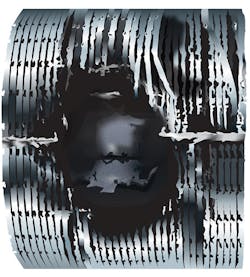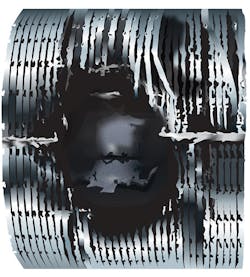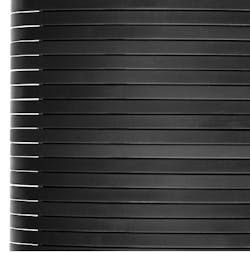Ceramic sand screens withstand severe downhole corrosion, erosion
Strong productivity gains in Norwegian, Malaysian wells
Richard Jackson
Bhargava Ram Gundemoni
3M Company
Sulaiman Sidek
Zainuddin Yusop
Petronas Carigali
Formation sand production is a persistent challenge for oil and gas producers, and the ability to control it is crucial to a well’s short-term and long-term economic viability.
In soft or weak geological formations, where high draw-downs are associated with optimized productivity measures, and also with aging assets, sand production can lead to choked production and damaged pipes and equipment. This can create health and safety issues, sometimes causing wells to shut down altogether.
Above: Hot-spotting erosion damage on a metallic screen. (All images courtesy 3M) Below: Silicon carbide sand screen filtration ring stack with gaps of 10 gage.
Common downhole sand control methods vary from standalone screens to gravel packs. Some situations, however, can compromise the effectiveness of these solutions. For example, sand particles can quickly erode metallic screens, especially at high velocities, often forcing the operator to manage production to prevent high impingements at the metallic screen. While this downhole management helps reduce early screen failure due to erosion, it also impedes well production and tends to incur associated delays or losses, in terms of financial return on investment.
In addition, most metallic materials are vulnerable to corrosive fluids and high-pressure/high-temperature (HP/HT) operations. Alternative sand control options such as gravel packing can be both complex and costly and are not applicable to complex well configurations.
There is another technology that offers multiple benefits including optimized well productivity, reduced capital expenditure, and minimized risk of sand control failure (and its associated costs) over a well’s lifecycle. Ceramic materials are known for their extremely hard composition and resistance to high pressure, high temperature, abrasion and chemical corrosion. For this reason, 3M has adapted these materials for critical applications ranging from spacecraft components to military armor. In the oil and gas industry, the company uses ceramic materials to create parts for drilling motors, submersible pumps, petrochemical seals, telemetry tools and other equipment.
SEM ceramic coupon post test.
The ceramic sand screens are a downhole sand control system with a contained, modular design that can be easily run down the line and placed above or directly over perforations. Ceramic rings are manufactured to a desired slot requirement for the application’s particle size distribution and stacked sequentially over the perforated base pipe in modular form to provide the required sand control. The hard ceramic materials naturally resist erosion and give the screens greater durability under high-velocity flows compared to similar metallic screens. Their relatively simple design is easily adaptable to a wide variety of wells, including those in HP/HT environments and those requiring unusual configurations.
North Sea deployment
Since 2010, 3M has installed 45 ceramic sand screens throughout the world, with 20-25 further installations planned by the end of 2018.
Two of the completed well installations were in the Norwegian North Sea. Both had a history of erosion-related slowdowns and shutdowns, but a full re-work of the wells would have been cost-prohibitive in a low-price market. One was highly deviated at 85º with a dogleg of 5.8º/100 ft (30.5 m), making a rig-less deployment highly challenging. The operator had considered redeploying its existing sand control system or installing a new gravel pack system, but neither option appeared likely to improve production rates for the life of the wells. However, ceramic sand screens were quickly deployed on E-line with a tractor and straddled in four and five runs. The robust downhole sand control drove a huge increase in production: prior to installation of the ceramic sand screens, the wells were producing only 100 b/d; post-deployment, production shot up to 2,500 b/d.
Petronas also commissioned 3M ceramic sand screens to revive wells offshore Malaysia. Sand mitigation equipment was experiencing rapid erosion, forcing the company to reduce production or, in certain cases, shut down wells altogether. Analysis showed that ceramic sand screens would cost 30% less and have a 50% higher ROI than other remedies. In practice, ROI has turned out to be better: Petronas’ current total oil production from these wells is 15% higher than projected. The company now plans to deploy more ceramic sand screens in its Peninsular Malaysia and Sabah operations in 3Q 2018, and to share its experience with 3M on other oil and gas operations elsewhere in Malaysia.
Laboratory tests of the ceramic sand screens involved trials on ceramic coupons with a 250µm slot opening, with conditions designed to mimic extreme hot spotting situations. The ceramic coupon was magnified with SEM, with no widening of the slot opening leading to any detectable loss of sand control. The ceramic sand screens have been tested and qualified for corrosion, bending, collapsing, and bursting.
The present oil price uncertainty will likely prevail for some time, and drilling lower-risk wells will therefore become a necessity. With an effective, long-term sand control solution that works well in HP/HT environments, producers can confidently drill in formerly high-risk locations. For this reason, operators are now considering ceramic sand screens before they start to drill new wells.
The authors
Richard Jackson has worked in the upstream oil and gas industry in 1996. He has worked on various offshore and onshore drilling sites, with a focus on improving well performance monitoring and production. He joined 3M in 2013 to help introduce advanced ceramic technologies to the industry. He holds an honors degree in geology.
Bhargava Ram Gundemoni holds a Master’s degree in Mechanical Engineering and has over 10 years of industry experience. He joined the upstream oil and gas industry in 2012 and is currently employed at 3M as a global sales and application advisor for 3M Technical Ceramics. His focus is on the ceramic sand screen product portfolio, covering completions in the Asia-Pacific region, Africa and the Middle East Asia. He has authored and co-authored many SPE publications.
Zainuddin Yusop holds his B.Sc. in Mechanical Engineering from Georgia Institute of Technology, USA and his M.Sc. Degree in Petroleum Engineering from Universiti Teknologi Petronas, Malaysia. He began his career in Petronas as an inspection engineer in 1992, progressing thereafter in various disciplines such as operations, maintenance, HSE and project management. He is currently Head of Subsurface, Petronas Carigali Sarawak.
Sulaiman Sidek graduated from Universiti Teknologi Petronas in 2005. He began his career in Petronas Carigali as a well testing engineer in 2006. He was transferred to the company’s Oman operation in 2012 and then to its Iraq operation from 2013 to 2015. He is currently engaged in Sarawak as a production technologist.



